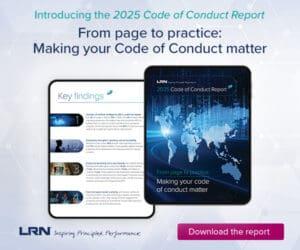Amy Landry recently shifted gears in moving from a vendor-side position advising clients to managing compliance in-house. Here, she discusses the differences in those roles and how incentive can determine the success of a program.
In my former career on the vendor side, one of my main responsibilities was to advise our customers on how the product they just purchased would help them solve <blank> need. That involved how best to implement, communicate and train their employees on this change. Now, as an in-house practitioner, my responsibility is not only to advise on an end-to-end plan (say, to launch the code of conduct), but also to execute the full plan, monitor it, and manage any changes or improvements to ensure the activity is making our program effective in preventing and detecting misconduct.
In my vendor days, I would manage five to seven customer projects at a time, but that was easy since I was just managing a small part of their program (e.g., developing an e-learning training course on anti-bribery or implementing their gifts, travel and hospitality process). Yes, I needed to understand not only their needs and pain points to provide them with the best service, but also the seven elements of an effective compliance program and the DOJ’s guidance. But this was more for demonstrating here’s how to spot a pain point and how the product will alleviate it, plus how it will help the company adhere to the seven elements guidance. In our role, we would suggest and recommend – but the work needed to handle the rollout ultimately fell to the customer. And, going forward, they had to monitor it and manage it for both improvements and effectiveness.
I would always hope that our customers would follow through on the suggestions. I didn’t want them to just add the product to a pretty paper-based program, but, instead, generate a robust and effective program. There was no guarantee, however, as I was not monitoring and managing day in and day out. Once I turned everything over to the customer, it was all in their hands.
The story is different when you’re an in-house practitioner in charge of or supporting the ethics and compliance program; you have actual skin in the game. As Matt Kelly shared in “Corporate Compliance Programs: Everything You Need to Know,
“An effective corporate compliance program demonstrates that your organization is aware of the rules and laws that apply to it, and takes reasonable, sincere steps to stay on the right side of those rules and laws.”
Bottom line: You want to help protect your organization from getting into trouble. To do this, you do everything you can to help promote an ethical culture based on your organization’s values. You review all your compliance program activities to identify the pulse of your organization – and hope to see improvement year over year.
So, this brings me to new responsibilities as I mentioned previously. I am now responsible not only for recommending or advising a plan based on a change in a law, policy or guidance (aka a need, a pain point), but also for executing that plan, monitoring to see how effective it is and, finally, making any changes to drive improvement.
It’s in my power to ensure the program is delivering on its promise, and that feels so good.












